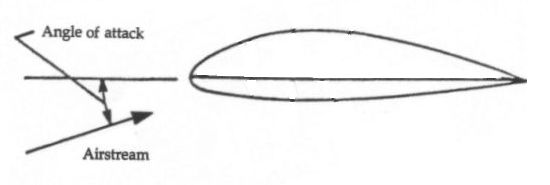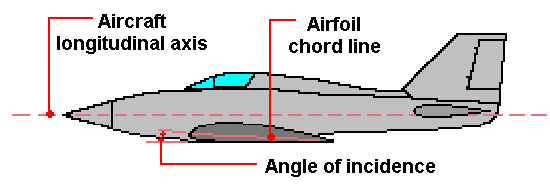i was going through a plan and i came across this area of the wing which mentions angle of incidence, no idea wat it means and how do i go about meeting those requirements in building the building process.
Announcement
Collapse
No announcement yet.
what is angle of incidence?
Collapse
X
-
ANGLE OF INCIDENCE
The angle of incidence is the angle at which the wing is permanently inclined to the airplane’s longitudinal axis.

Choosing the right angle of incidence can improve flight visibility, enhance take-off and landing characteristics and reduce drag in level flight.
The angle of incidence that is usually chosen is the angle of attack at which the lift-drag ratio is optimum. In most modern airplanes, there is a small positive angle of incidence so that the wing has a slight angle of attack when the airplane is in level cruising flight.
SKY HOBBIES SINGAPORE
200, Jalan Sultan, #02-36A, Textile Centre, Singapore 199018. (along Jalan Sultan)
2 Blocks away from KEYPOINT, Nearest MRT - Lavender MRT, ICA building side
Tel : +65 6293 3968
Website:
Official You Tube Channel
FACEBOOK :
-
so basically the how u mount the wing yea?Choosing the right angle of incidence can improve flight visibility, enhance take-off and landing characteristics and reduce drag in level flight.
The angle of incidence that is usually chosen is the angle of attack at which the lift-drag ratio is optimum. In most modern airplanes, there is a small positive angle of incidence so that the wing has a slight angle of attack when the airplane is in level cruising flight.
Comment
-
Angle of Incidence is measured using the CHORD LINE of the wing chord parallel with the longitudinal axis of the aeroplane trust line.
Angle of Attack refers to the angle using the CHORD LINE of the wing chord against the air stream direction...
Extracts for you to read on...
Angle of Attack and Pitch Angle
Typical airfoil at an angle of attack
Note that the direction of the air stream is drawn as being level while the airfoil is tilted upward. Illustrations like these often lead people to believe that angle of attack is the attitude of the vehicle with respect to a level surface. However, it would be just as valid to draw the same image with the airfoil level and the direction of airflow inclined at some angle.

Typical airfoil at an angle of attack
In addition, the same situation could be presented with neither the airfoil nor the airflow level, but both at some arbitrary angle.
Typical airfoil at an angle of attack
Nevertheless, the airfoil remains at the same angle of attack in each of the three cases shown above. Why? The explanation is that angle of attack is not measured from a level plane but is defined as the angle between the airfoil chord line and the relative wind. The relative wind is a term often used in aerodynamics describing the direction at which a vehicle in flight meets the oncoming air stream.
Definition of angle of attack on an airfoil
It is very important not to confuse angle of attack with other commonly used angles in aviation. One of these common misconceptions is the confusion between angle of attack and angle of incidence. On many aircraft, like that drawn below, the wing is inclined at some angle to the plane's fuselage.

Definition of angle of incidence on an airplane wing
We measure this angle between an axis running the length of the aircraft, called the longitudinal or x-axis, and the chord line of the wing airfoil and call this value the angle of incidence. The angle of incidence is usually fixed for any given aircraft and never changes.
Another key angle that is most often confused with angle of attack is called the aircraft pitch angle. Pitch angle is one of three angles that are called Euler angles. These three angles define the orientation of the aircraft in roll, pitch, and yaw with respect to a fixed reference coordinate system.
SKY HOBBIES SINGAPORE
200, Jalan Sultan, #02-36A, Textile Centre, Singapore 199018. (along Jalan Sultan)
2 Blocks away from KEYPOINT, Nearest MRT - Lavender MRT, ICA building side
Tel : +65 6293 3968
Website:
Official You Tube Channel
FACEBOOK :
Comment
-
Look for master TONY on this forum as he is a very season builder to answer your building techinques. Me not quite good in building tips but I see the 1 deg AOI seems almost parallel with the trust line. Very difficult to gauge that "1 deg".
But first you must determine your wing chord line...


SKY HOBBIES SINGAPORE
200, Jalan Sultan, #02-36A, Textile Centre, Singapore 199018. (along Jalan Sultan)
2 Blocks away from KEYPOINT, Nearest MRT - Lavender MRT, ICA building side
Tel : +65 6293 3968
Website:
Official You Tube Channel
FACEBOOK :
Comment
-
wing angle of incidence contributes to drag and lift by a considerable amount, given by Lift = Cl*((r vsquared)/2)*AOriginally posted by SKYHOBBIESANGLE OF INCIDENCE
The angle of incidence is the angle at which the wing is permanently inclined to the airplane’s longitudinal axis.

Choosing the right angle of incidence can improve flight visibility, enhance take-off and landing characteristics and reduce drag in level flight.
The angle of incidence that is usually chosen is the angle of attack at which the lift-drag ratio is optimum. In most modern airplanes, there is a small positive angle of incidence so that the wing has a slight angle of attack when the airplane is in level cruising flight.
where cl is 2*pi*angle of attack in radians. r is air pressure in psi and v is speed into wind in kmh and A is wing area.
however, this contributes to what induced drag. which is shown by the equation Cl/pi*Ar
Cl is mentioned earlier. to measure angle of attack, use the two points at which the width of that section of whing is longest and draw an imaginary line, that line if parallel with the thrust of the aircraft, would mean that angle os attack = 0 degrees.
why dun you try using the equations and calculate? it might give you a good answer on how to go about doing things. note- lift has to be more than weight in newtons for takeoff. have fun! 8UHP
8UHP
Easyglider stock setup(DECOMMED) (new one coming soon)
World Models 'Voodoo' mustang
Comment
-
Hey man! Need some advice too.... how do you use these tools to get the incidence? Plus - after we get the incidence, how do we cut out the fuselage sides so that we can fit the wing in?Originally posted by slackerzyou just need a protractor, clamp, vernier caliper and a steady pair of hands.
I suspect though, that the 1 degree incidence is pre-drawn on the plan's fuselage side. The line in the plans would be just be purely "FYI".
Comment
-
Yeah i think the major problem lies with accuracy of building. I cant imagine myself building to an accuracy of 1 degree or 1 mm! Yeah, i would like to know how to use those tools to measure wing incidence mainly to check my building accuracy.Originally posted by raghfrostyea i could make all the calculations but the problem now is to construct it with such accuracy. the pervious plane i built does not fly real well.. the reason y i wanna pay more attention to the aerodynamics this time round
Comment
-
totally agree with ya! most of the time i build most of my tools and stuff simple one off tools if u know wat i mean. some how i dont see my self investing 40 -50 bucks for tools u can make yaself. so i was wondering if any 1 on ya have any tips for make a tool for the incidence angle.Yeah i think the major problem lies with accuracy of building. I cant imagine myself building to an accuracy of 1 degree or 1 mm! Yeah, i would like to know how to use those tools to measure wing incidence mainly to check my building accuracy.
Comment



Comment